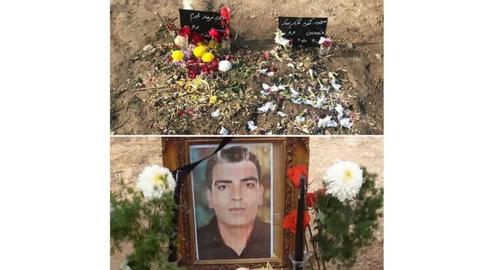At the time of writing, Richard Ratcliffe, husband of Nazanin Zaghari-Ratcliffe, had been on a wet hunger strike outside the British Foreign Office in London for 17 days. His body has begun to reach now, worrying his family. But there has been close to zero response from UK government officials – he had a single meeting with Foreign Secretary Liz Truss in the first week, but nothing more – and his wife remains a hostage in Iran.
According to the family, Richard has drunk just water, tea and coffee without sugar or milk over these 17 days. He has refused food to draw the world's attention to the crimes of the Islamic Republic, and in a bid to push British authorities to get her released.
Richard's family told IranWire he is rapidly losing strength and remains sat on a chair most of the time. He has layered up his clothes because of exacerbated feeling of cold, and has been told he ought to be accompanied if he wants to walk anywhere. When he does walk, he often stumbles. All his reactions are slowed.
When Richard Ratcliffe went on hunger strike, he told the media that he had decided to do so knowing that he might end up in hospital. Fortunately his sister is a doctor and has been caring for her brother as best she can for the past two weeks. This week her husband, who is also a doctor, was by his side. But nothing can put a halt to the effects of protracted starvation on the body. New photos circulating on social media show him going paler.
Hunger strike as a form of protest dates back to ancient Rome. The person on hunger strike has decided to expose his or her physical and mental health to potential harm, in order to force some kind of change. The longer you close your mouth to food, the more the bodily systems are endangered. Sometimes the impact lasts forever.
People who are healthy before going on a wet hunger strike and have no underlying diseases are generally at risk of death at six to eight weeks. Dry hunger strikes, when the striker also refuses water, are much more dangerous and can kill within one to two weeks.
In a report for Radio Free Europe, Christina Fultinova has described what happens to the body on a wet hunger strike in this time:
Days 2-3: The body begins to lose fat and muscle and its resistance to infections decreases.
Day 14: Dizziness, weakness, difficulty standing, a low heart rate, and chills are likely.
Day 21: The striker may suffer nerve problems and a loss of motor skills
Day 30: They may have difficulty drinking water, and suffer hearing and vision loss, as well as the beginnings of organ failure.
Day 42: The striker is at increased risk of going into cardiac arrest.
Humans can survive for weeks without food under certain conditions. But the physical and psychological damage does get under way quickly. Dr. Mahbod Ebrahimi has previously explained in an article that the human body reacts to the lack of food from the very first few hours. The lack of carbohydrates makes the body turn to its own fat and protein reserves – and ultimately, muscle tissue – for energy.
The Red Cross describes hunger strike in a report as a common “last resort”, especially in countries where prisoners' rights are not respected. It can, the organization says, be used to “shame” authorities who have closed their eyes and ears to protesters’ demands, forcing them to use their own bodies where open letters, placards and dialogue failed. For Richard Ratcliffe, this is a last resort.
Because of how seriously hunger strikes weaken the immune system, an extra cause for concern that Richard Ratcliffe has gone on hunger strike in the middle of a cold English winter and a pandemic, with other bugs like influenza also doing the rounds. But UK politicians still don’t seem to be paying attention.
Many individuals and groups in history have gone on hunger strike. Perhaps the best description of the act was given by William Butler Yeats in the play The King's Threshold, which tells the story of a bard who goes on hunger strike against the king:
"He has chosen death: Refusing to eat or drink; that if a man be wronged and starve Upon another's threshold till he die, The common people, for all time to come, Will raise a heavy cry against that threshold, Even though it be the King's."
Related coverage:
Husband Calls for 'Game' to End on Nazanin's 2,000th Day of Detention
Judiciary Says Nazanin Zaghari-Ratcliffe “Should Thank the Islamic Republic”
Revolutionary Court Sentences Nazanin to Another Year Behind Bars
The British-Iranian Hostages Iran Labels as Terrorists
Nazanin's Husband: Hostage-Taking by Iran Must End
Judiciary Secretary Claims Hostages Want to Stay in Iranian Prisons
"He Thought We'd be Safe if he Died": Family Reveals British-Iranian's Suicide Attempts in Prison
visit the accountability section
In this section of Iran Wire, you can contact the officials and launch your campaign for various problems
























comments